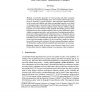Free Online Productivity Tools
i2Speak
i2Symbol
i2OCR
iTex2Img
iWeb2Print
iWeb2Shot
i2Type
iPdf2Split
iPdf2Merge
i2Bopomofo
i2Arabic
i2Style
i2Image
i2PDF
iLatex2Rtf
Sci2ools
ECCV
2004
Springer
2004
Springer
Detecting Keypoints with Stable Position, Orientation, and Scale under Illumination Changes
Local feature approaches to vision geometry and object recognition are based on selecting and matching sparse sets of visually salient image points, known as `keypoints' or `points of interest'. Their performance depends critically on the accuracy and reliability with which corresponding keypoints can be found in subsequent images. Among the many existing keypoint selection criteria, the popular F?orstner-Harris approach explicitly targets geometric stability, defining keypoints to be points that have locally maximal self-matching precision under translational least squares template matching. However, many applications require stability in orientation and scale as well as in position. Detecting translational keypoints and verifying orientation/scale behaviour post hoc is suboptimal, and can be misleading when different motion variables interact. We give a more principled formulation, based on extending the F?orstner-Harris approach to general motion models and robust template...
Applications Require Stability | Computer Vision | ECCV 2004 | Keypoint Selection Criteria | Robust Template Matching | Salient Image Points | Translational Keypoints |
Related Content
| Added | 15 Oct 2009 |
| Updated | 15 Oct 2009 |
| Type | Conference |
| Year | 2004 |
| Where | ECCV |
| Authors | Bill Triggs |
Comments (0)

